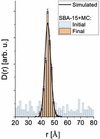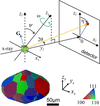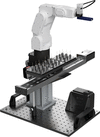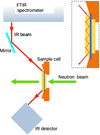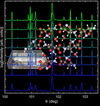issue contents
October 2023 issue

Cover illustration: Penacchio et al. [J. Appl. Cryst. (2023), 56, 1574–1584] introduce PyDDT, a free Python package of computer codes for exploiting X-ray dynamic multiple diffraction in single crystals.
scientific commentaries
Open  access
access
 access
accessA recent article by Brookes, Rocco, Vachette & Trewhella [J. Appl. Cryst. (2023), 56, 910–926] on improving the accuracy of AlphaFold structural predictions for disordered proteins is discussed.
research papers
Download citation


Download citation


Open  access
access
 access
accessEnabling of an In Kα MetalJet source is described, culminating in the first charge-density investigation.
CCDC reference: 2288995
Download citation


Download citation


Open  access
access
 access
accessThis paper communicates the first application of MetalJet In Kα radiation to single-crystal X-ray crystallography and evaluates two different detectors, the Bruker Photon III and the Dectris Eiger2 CdTe, for usage in spherical and aspherical structural models.
Open  access
access
 access
accessA strategy to simulate and fit 2D grazing-incidence small-angle X-ray scattering patterns of supported, nanostructured soft-matter thin films using the distorted-wave Born approximation is introduced. The different scattering contributions of the nanostructure, surface roughness and background scattering are treated separately and are adjusted step by step. To minimize calculation efforts, 1D line cuts are chosen, in which the scattering is predominantly attributed to one of the contributions, and the parameters found are used in the subsequent steps. Hence, separate measurements of the bare substrate are beneficial.
Open  access
access
 access
accessAn approach to simulating small-angle X-ray and neutron scattering curves of planar bilayers with horizontally correlated inhomogeneities representing lipid domains, proteins or pores is presented.
Open  access
access
 access
accessA versatile approach for the preparation of high-density membrane protein microcrystals in lipidic cubic phase for serial crystallography is described.
PDB references: room-temperature structure of the stabilized A2A–LUAA47070 complex determined by synchrotron serial crystallography, 8a2p; room-temperature structure of the stabilized A2A–theophylline complex determined by synchrotron serial crystallography, 8a2o; room-temperature structure of archaerhodopsin-3 dark-adapted, 6guy; room-temperature structure of archaerhodopsin-3 obtained 110 ns after photoexcitation, 7zy3
Open  access
access
 access
accessThis study examines the time evolution of microscopic structure in a model industrial process, a sol of gel-initiated silica particles in a simple Couette shear field, using small-angle neutron scattering SANS) and ultra-small-angle neutron scattering (USANS) over a large range of scattering vector magnitudes/length scales. Comparison of the experimentally derived parameters with a simple theoretical model provides additional insight.
Open  access
access
 access
accessThe new model proposed in this work allows retrieval of the mesopore size distribution of SBA-15 (and similar ordered mesoporous materials) from small-angle X-ray scattering data using a free modelling approach. According to the obtained results, even more complex size distributions can be recovered, such as the case of SBA-15 with expanded mesopores.
A multielectrode-based electrochemical cell allows the structural characterization of amorphous thin-film catalysts under reaction conditions using a high-energy X-ray scattering technique.
In this work, the crystallite size, texture and phase volume fraction of type 304 stainless steel samples were measured using Bragg edge imaging and were validated by the electron backscatter diffraction method. The Bragg edge imaging results were obtained using a compact accelerator neutron source.
The microstructure of α-Fe was investigated by an inclined scanning 3D X-ray diffraction (iS3DXRD) microscopy technique. By combining iS3DXRD with sub-voxel analysis, a spatial resolution of 2.5 µm was achieved, a quarter of the incident X-ray beam size.
The residual mismatch related to stacking faults in SrTiO3-based Ruddlesden–Popper (RP) structures is shown to be accommodated by a delocalized mechanism of lateral strain transfer from the disturbed regions to the RP structure, generating a distribution of compressive strain in the latter. The methodology used to show this mechanism, based on X-ray diffraction experiments, also allows the assessment of the stacking fault spatial distribution and the accurate determination of the interplanar distance separating the two SrO planes forming the defects.
The multiprobe nature of the grazing-emission X-ray fluorescence approach in contrast to the conventional grazing-incidence X-ray fluorescence or X-ray standing-wave technique is investigated. A semi-analytic solution taking into account both grazing-incidence and grazing-emission geometries is derived. This solution is used to study the anomalous Kossel effect.
Open  access
access
 access
accessA numerical method that provides the surface and bulk X-ray elastic constants of non-textured polycrystalline materials is proposed. The results obtained for engineering materials with such a method indicate that, for crystalline materials with significant elastic anisotropy, the X-ray elastic constants depend on the penetration-depth-to-grain-size ratio.
Open  access
access
 access
accessStructural changes and phase transitions of ferroelectric Ba2NaNb5O15 are studied using high-resolution X-ray powder diffraction combined with neutron powder diffraction and density functional theory calculations.
An unequivocal relationship between diffraction peak shape and crystallite size distribution has been derived. A procedure to separate the diffraction peak shape contribution arising from the effect of crystallite size is described. Application of this approach is established using several worked examples of practical situations from the literature.
Open  access
access
 access
accessThe general-purpose powder diffraction beamline at Stanford Synchrotron Radiation Lightsource (SSRL) is described. The latest developments at the beamline, including the implementation of a robotic sample changer for mail-in operations, are discussed and several datasets measured from this setup are included for reference.
The HETU neutron diffractometer has been developed to enable a high instrument resolution measurement mode or a high neutron flux mode, with use of a double-focusing perfect single-crystal silicon monochromator or a highly oriented pyrolytic graphite monochromator, for investigations of residual stress and texture of engineering materials and components.
Open  access
access
 access
accessThis article describes a qualitative study to unpack the internal workings of convolutional neural networks with the aim of visualizing information in the fundamental blocks of a standard network with serial crystallography data. Moreover, the study highlights region(s) or part(s) of an image that mostly contribute to a hit or miss prediction.
The batch production and performance evaluation of the spherically bent crystal analyzers fabricated for the `Qian Kun' X-ray Raman spectrometer at the High Energy Photon Source in China are reported. Radially dicing thin silicon wafers was found to be more effective in relieving stress than conventional strip cuts in the case that the total number of divided blocks is roughly the same.
The applicability of time-of-flight spin-echo small-angle neutron scattering to the study of the inner fractal structure of the nuclei of biological cells is demonstrated. The method is used to show the logarithmic fractal structure of the large-scale organization of chromatin in rat lymphocyte nuclei.
Open  access
access
 access
accessA simultaneous small-angle neutron scattering (SANS) and infrared absorption measurement system using the attenuated total reflection (ATF) sampling method for Fourier transform infrared (FTIR) spectroscopy has been developed to handle samples with large infrared absorption. This system allows each measurement to be performed under appropriate conditions.
The proposed method facilitates current Bragg coherent diffraction imaging by employing wavefront modulation. Extensive numerical simulations prove that the technique works well for general samples, and the iterative algorithm exhibits fast convergence and high robustness.
A strategy grounded on the central-moment-expansion approach is proposed for addressing the resolution discrepancy inherent in cross-sectional measurements obtained via small-angle scattering experiments.
teaching and education
Open  access
access
 access
accessA variable educational exit game is presented to stimulate interest of young people in STEM-related fields. The game addresses scientific content from crystallography, materials science and related fields and is suitable for a wide range of player groups, such as secondary school pupils, undergraduate students and teachers.
Free 

This paper describes a hands-on crystallization laboratory exercise that can be carried out remotely at home with safe household products. The project meets some of the US Next Generation Science Standards (NGSS) goals for K-12 education, including teaching scientific practices that reflect those used by professional scientists.
PDB reference: hen egg-white lysozyme grown with kitchen recipe, 7knk
short communications
Download citation


Download citation


A cocrystal of 4,4′,5,5′-tetranitro-1H,1′H-(2,2′-biimidazole)-1,1′-diamine (DATNBI) and TNT with a molar ratio of 1:2 was synthesized for the first time. The thermal decomposition temperature and mechanical sensitivity of the cocrystal have been greatly improved compared with DATNBI, which provides a certain basic support for the subsequent cocrystal design of DATNBI.
CCDC reference: 2097129
computer programs
Open  access
access
 access
accessComputer simulation tools are presented for the easy exploration of dynamic diffraction in refining structural details of known materials. Here several practical examples illustrate their usage, covering all steps from designing of experiments to data analysis.
Open  access
access
 access
accessA customizable stateless graphical user interface simplifies the processing, analysis and phasing of diffraction data.
Open  access
access
 access
accessThis article describes the GRASP software package, designed for the graphical inspection, reduction and analysis of multidetector data produced by the small-angle neutron scattering instruments at the Institut Laue–Langevin and other neutron sources.
Open  access
access
 access
accessAn upgrade is presented to the popular LauePt program for indexing and simulating X-ray Laue patterns. The upgraded program allows for recognizing and fitting Laue patterns of any crystal type recorded under any diffraction geometry.

 journal menu
journal menu


















